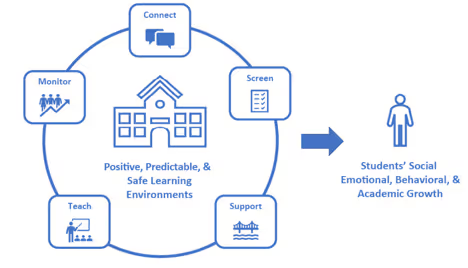

Recovery from a crisis event is a long-term process best guided by a representative leadership team. Our resources are designed to support families, educators, schools, districts, and states throughout the phases of crisis recovery following a significant crisis event that disrupted the learning environment. While everyone’s path to recovery is unique, there are community-level trends that we can use to predict levels of need across time and guide recovery planning (Adapted from Mauseth, Covington, Chan, Frazier (in preparation). We describe each phase and specific action items below.
Follow the steps below to support recovery. If your district or state is looking for external support or technical assistance for crisis prevention, preparation, response, or recovery, please contact your state PBIS coordinator.

To maximize both benefit and efficiency, enhance and adjust existing systems to support implementation. Use existing leadership team structures to develop, implement, and monitor a recovery plan.



Focus on a small number of evidence-based and culturally relevant practices, across social, emotional, behavioral, and academic domains, that have an equitable and measurable impact and invest in doing them well. Every situation is unique and the greater the impact of an event the greater the need for schools to intensify support. Student-teacher relationships are one of the most powerful predictors of student emotional wellness, classroom climate, and academic success. Getting back to “routine” is one of the key pillars of recovery, take it slowly and be flexible but move purposefully back toward routines. Throughout the recovery process, be mindful of the situations and experiences that affect and overwhelm your emotional state, cause distress, and make it difficult to stay in the moment. In these moments, remember to go back to the basics of what we know works.

This phase begins with the onset of the crisis event and encompasses the time during which schools are closed or significantly disrupted. Following the immediate responses, the school and district must begin planning for re-opening. The primary goal during this time is to ensure safety. This phase occurs hours to weeks post-incident.
Common responses may include difficulty concentrating, sleep disturbance, separation anxiety, hyperactivity, and crying spells. These symptoms in the first few weeks following a traumatic event are normal. Symptoms at this point are not indicative of longer-term challenges and can be addressed as normal responses to the grief and violation of safety that was experienced. Crisis events affect everyone differently. Students who have struggled in school before the crisis event may need more intensive support in this phase.

This phase generally begins when schools re-open as the district transitions from rescue to initial recovery. Resources are directed toward social, emotional, and behavioral supports and the goal is to stabilize the learning environment and promote a sense of community for healing. This phase occurs weeks to months post-incident.
Social cohesion and external support are strong during this phase and community members may have an unrealistic perception of recovery and the extent of the impact.

This phase occurs months post-incident and may include the start of the next school year. The goal during this time is to use data to begin to differentiate supports and plan for long-term recovery.
This is a challenging phase during which much of the immediate sense of social cohesion and outside support may fade. Social, emotional, and behavioral needs are likely to increase in both acuity levels and number of people needing support. Educators, students, and family members may experience increased levels of exhaustion, grief, loss, and hopelessness. Because everyone moves through the recovery process at different rates, community cohesion may be eroded as some community members are “ready to move on” while others are still really struggling. Depression or suicide ideation or attempts may increase during this time.

During this phase school districts develop an enhanced full continuum of supports that meets the ongoing needs of staff and students and use data to monitor progress and match supports to existing and emerging needs. This phase occurs months to years post-incident. The goal is to establish a culture of wellness grounded in community connections and collaboration.
Educators, students, and family members may experience reconnection, adjustment, and a renewed sense of purpose and hope. Exhaustion, grief, and loss may continue for some. Disaster cascade effects may occur if additional traumatic incidents impact individuals or the community.